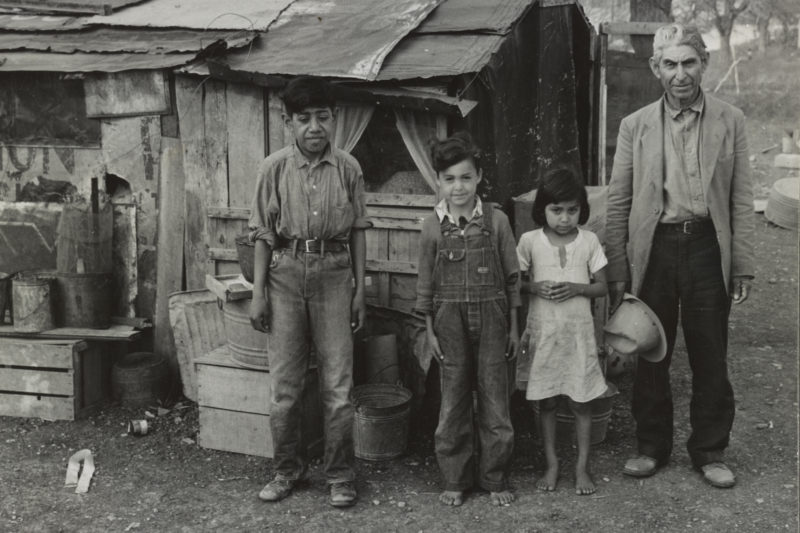A Historical Look at Jim Crow Laws in Texas
By Jillian Price
Reporting Texas

An archival photo shows a Mexican American man and three children standing in front of a homemade shack opposite the Santa Rita Courts in Austin, Texas, the first public housing development completed under the Housing Act of 1937. Photo courtesy of the Library of Congress
Texas and other states are adopting strict voting laws as former President Trump pushes his Big Lie, the false assertion that the 2020 election was stolen from him. Some people have described the voting restrictions as a new form of Jim Crow laws. Historically, Jim Crow laws used literacy tests, property requirements and grandfather clauses to limit the number of Black people allowed to vote. Charles Zelden, history professor at Nova Southeastern University in Florida, sat down with Reporting Texas to discuss the unfortunate history of Jim Crow in Texas. Zelden received his Ph.D from Rice University in history and is the author of several books, including “The Battle for the Black Ballot.” Here’s a transcript of the conversation, edited for clarity:
What are Jim Crow laws?
Jim Crow was a way to exclude African Americans, using poverty, using an unfair and racially biased, criminal justice system. And, doing what we today call cracking or packing, also called gerrymandering. They packed all the African Americans into one district, which made the remaining districts more white. So, African Americans, even if they could vote, they weren’t going to choose a candidate of their choice. So it was a mix of what we call vote denial and vote dilution. Vote dilution is when you can vote but you’re not going to win. It really took off with the Jim Crow disenfranchisement around 1898 to 1905. In that period, all the southern states passed laws that came up with ways to exclude African Americans. One sort of universal approach was a poll tax, which you had to pay in order to vote. It often wasn’t a lot of money, but what it did do was exclude people who were in extreme poverty. A large chunk of those people were African American, but there were also a lot of poor whites.
How did it work in Texas?
In Texas, they depended on two things. The first thing they depended on was the poll tax. So there were a lot of poor farmers in Texas, and most African Americans were poor farmers in Texas, and this is a way to exclude them. But that still left about 7,000 to 8,000 urban middle class blacks who could pay the tax. And so what Texas did, and ultimately what the rest of the South did, is they implemented something called a white primary. In 1902, a law was passed that basically said that political parties could determine who their members were. And if you weren’t a member, you couldn’t vote in the primary election. Democrats immediately said you had to be white in order to be Democrat.
When would you say Jim Crow laws were over?
Jim Crow ends by the mid ‘60s. That doesn’t mean things get better immediately. That doesn’t mean that race isn’t an issue, but that the formal rules that we call Jim Crow were finally done away with by the mid ‘60s by a series of acts, the Civil Rights Act of 1964, the Voting Rights Act 1965 and the Fair Housing Act of 1968. But in 2010, the Supreme Court gutted the Voting Rights Act of1965 and in the process made it so much easier not to deny someone the vote, but to make it much harder for them to apply their vote.
Could you talk about Austin specifically?
The thing about Austin is that it’s probably the most liberal city in Texas, but it’s on the edge of the Hill Country, which is one of the more conservative areas of Texas. So while the city of Austin is very liberal, if you include the people who live in the Hill Country, it’s not so liberal. So Austin is not one congressional district. And so the idea is if 30% of a district is going to be from Austin, even if all 30% show up and vote, that’s still not enough to win. This is what we call vote dilution.
What is the new Jim Crow?
The new Jim Crow is basically saying, it’s not worth the effort. You’re going to go through all this effort, you’re going to lose anyway. We’re still gonna figure out ways to keep you from getting what you want, so why bother. It’s a form of voter dilution, a form of voter suppression, but what it isn’t is voter denial…with the exception of voter disenfranchisement. So it is the same vinegar, if you will, on the bottle as during Jim Crow, but it’s a new bottle. The method is somewhat different. It’s less extreme, it’s less complete, but the intent is the same.
Is history repeating itself?
What’s the old line, ‘History doesn’t repeat itself, but it sure does rhyme.’ I think at this point we’re in two-part harmony. This is the same old vinegar. You know, nasty and bitter and all that, but it’s in a bottle that isn’t as extreme. The intent is the same, but the method is not as overwhelming, not as blatantly racist, as it was back at the turn of the 20th century.
Do you think it’ll ever change?
Well, the fight over who can vote will never go away, because that’s part of politics. There are two ways to win: convince more people to vote for you or convince more people who are going to vote against you not to vote. That’s not going to go away. What will hopefully happen is that this effort at voter suppression, that’s becoming very blatant, will go too far.